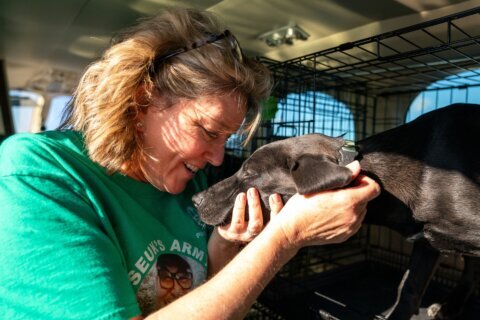With temperatures hiking in much of the US as an oppressive heat wave continues, zoos are taking special measures to keep their animals cool.
Think: frozen bug popsicles, mud showers and long pool days. You know, the basics.
At the Smithsonian National Zoo, swamp monkeys are usually offered yogurt popsicles on hot days and bison are hosed off, while vultures take cold baths.
In Houston, Texas, where temperatures reached the triple digits in the last week, it’s buckets of ice and frozen treats for the sea lions and goats at the Houston Zoo and cool showers for the tortoises.
And when things get too hot, animals are taken to their air-conditioned bedrooms.
Here’s how other zoos are keeping their residents comfortable.
Frozen treats and mud in Rhode Island
When the weather is hot in Providence, Rhode Island, the Roger Williams Park Zoo gives its animals more opportunities to seek out the best shady spots or venture into indoor areas with fans and air conditioning, said Vicki Scharfberg, a spokesperson with the zoo.
And that’s not all: the animals are able to cool down in refreshing mud or water, and even get frozen treats, Scharfberg said.
“And there are also things that we don’t do,” Scharfberg added. “We avoid doing any routine medical examinations during extreme heat. Animal Care Managers and keeper staff also avoid doing introductions of new animals during extreme weather conditions.”
Bloody popsicles in Massachusetts
Staff members across Zoo New England — which operates the Franklin Park Zoo in Boston and the Stone Zoo in Stoneham — know exactly what to do when the temperatures start climbing: frozen goodies.
At Franklin Park Zoo, gorillas get ice treats of diluted fruit juice and berries, while spotted hyenas get to enjoy ice treats of beef blood and water, Colleen McCormick Blair, a spokesperson with Zoo New England, told CNN.
Meanwhile, ring-tailed lemurs are given frozen bugs, the spokesperson said. Animals there also enjoy the luxuries of misters and other cooling mechanisms including sprinklers and pools.
And similar techniques are helping keep animals cool over at the Stone Zoo, including misters, extra fans, ice treats, as well as time indoors, McCormick Blair said.
Ice blocks and cooling logs in Ohio
In Ohio, Cleveland Metroparks Zoo team members have been keeping a close eye on the weather and have plenty of tools to help animals cool off when temperatures get too high.
First, there are cooling logs and caves for snow leopards and dipping streams for Amur tigers, said Jeff Tolman, a spokesperson for the park.
The zoo has also created shade structures and misting bars for rhinos, ice blocks for its grizzly bears and, on particularly hot days, staff members make sure African Elephants have plenty of opportunities to wallow in mud, which helps cool them off and protects their skin from the sun.
Extra fans and braids at one Pennsylvania farm
And it’s not just zoos who are looking to offer relief to their animals from the hot temperatures.
In Saxonburg, Pennsylvania, Jessica Poutous has more than 100 animals on the J and J Farms Animal Sanctuary she co-owns with her husband.
The couple have doubled the number of fans throughout their barn, and have added extra misting fans, pools, and are refilling water troughs several times each day.
“This year has been awful, there was barely any rain in June, so we’re in a drought on top of the heat,” Poutous said.
The couple is also braiding the manes of their horses — an hourslong task — to help them stay cool.
“Horses will sweat and become sticky to the point where we will even just go hose them down,” Coutous said.
And for the ducks on the property, many of whom are disabled, the couple has set up a pool to help them cool off and built a ramp to help them get in and out of it.
The-CNN-Wire
™ & © 2022 Cable News Network, Inc., a WarnerMedia Company. All rights reserved.






